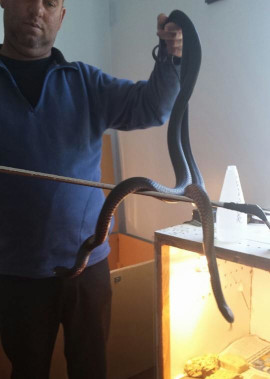
Snake handling is a specialized skill that requires knowledge, training, and a deep understanding of these remarkable reptiles. For aspiring snake catchers, it's essential to prioritize safety for both the snakes and themselves. In this article, we'll explore some crucial tips and guidelines for safely handling snakes.
1. Education and Training
Before attempting to handle snakes, it's imperative to educate yourself about different snake species, their behavior, and the laws and regulations in your area. Seek training from experienced herpetologists or wildlife experts. Learning about venomous snake identification and safety procedures is especially critical.
2. Safety Gear
Always use the appropriate safety gear when handling snakes. This includes:
-
Snake Hooks: Snake hooks allow you to lift and manipulate snakes from a safe distance. Use hooks with gentle tips to avoid injuring the snake.
-
Snake Tongs: Snake tongs are used for capturing snakes at a distance. They come in various sizes and are an essential tool for keeping a safe distance while handling snakes.
-
Gloves: Wear thick, bite-resistant gloves when handling snakes, especially if you are working with venomous species.
-
Protective Clothing: Dress in long sleeves and pants to minimize exposure to snake bites. High boots can also provide additional protection.
3. Identify the Snake
Before attempting to handle any snake, it's crucial to identify the species. This is especially important when dealing with venomous snakes. Never approach or handle a snake if you are unsure of its identity.
4. Approach Slowly and Gently
When approaching a snake, move slowly and calmly. Do not make sudden or aggressive movements, as this can startle the snake. Use a snake hook or tongs to gently lift the snake off the ground if necessary.
5. Maintain a Safe Distance
For venomous snakes, always maintain a safe distance. Do not underestimate the striking range of a snake. It's essential to respect their space and avoid unnecessary risks.
6. Do Not Harass or Stress the Snake
Handling snakes can be stressful for them. Minimize handling time, and release the snake as soon as possible. Avoid unnecessary handling or harassment, as this can harm the snake's health.
7. Proper Containment
When capturing a snake, use a secure container that is escape-proof. Ventilation is crucial to ensure the snake has enough air. Do not use containers that could harm the snake's scales or teeth.
8. Never Free-Handle Venomous Snakes
Free-handling venomous snakes, a practice often seen in movies or on social media, is extremely dangerous and should be avoided at all costs. Even experienced snake handlers rarely free-handle venomous snakes.
9. First Aid and Medical Attention
In case of a snakebite, it's vital to have knowledge of first aid procedures and seek immediate medical attention. Do not attempt to suck out the venom, cut the wound, or use a tourniquet, as these practices are not effective and can worsen the situation.
10. Release Snakes Safely
Whenever possible, release captured snakes in their natural habitat. Ensure you release them far from human habitation to reduce the risk of conflict.
TLDR;
Snake handling is a skill that demands respect, care, and a commitment to safety. Whether you're an aspiring snake catcher or simply interested in handling snakes responsibly, following these guidelines can help protect both you and these incredible reptiles. Always remember that the safety and well-being of the snake should be your top priority.